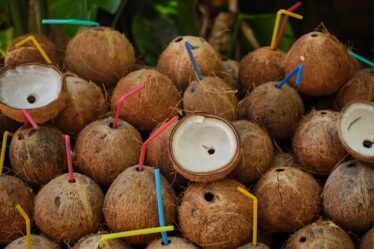
The vodka martini emerged as a variation of the classic gin martini in the early 20th century. As vodka gained popularity in the United States during the mid-20th century, it began to replace gin in this iconic cocktail. The vodka martini consists of vodka and vermouth, typically garnished with an olive or a lemon twist.
While its exact origins are uncertain, the drink gained significant popularity in the 1950s and 1960s, partly due to its association with cultural figures like James Bond, who famously ordered his martinis “shaken, not stirred.”
The vodka martini has since become a staple in cocktail culture, known for its simplicity and elegance. It has been featured prominently in films, television shows, and literature, cementing its status as a timeless and iconic drink. The cocktail’s association with sophistication and glamour has made it popular among cocktail enthusiasts and socialites.
Over the years, bartenders and mixologists have experimented with various ingredients and techniques, creating new variations of this classic drink. The vodka martini remains a symbol of style and refinement, with a rich history spanning more than a century.
Key Takeaways
- The Vodka Martini has a rich history dating back to the 1950s, popularized by James Bond in the novel “Casino Royale.”
- When choosing vodka for your martini, opt for a high-quality, neutral-flavored vodka to allow the vermouth and garnishes to shine.
- The perfect ratio of vodka to vermouth is a matter of personal preference, but a common starting point is 3 parts vodka to 1 part vermouth.
- The debate between shaking and stirring a vodka martini continues, with shaking creating a more diluted and colder martini, while stirring maintains a smoother texture.
- Garnishes such as olives or lemon twists are essential in a vodka martini, adding flavor and visual appeal to the cocktail.
Choosing the Right Vodka for Your Martini
The Importance of High-Quality Vodka
Selecting a high-quality vodka is vital, as it will result in a more refined and enjoyable martini. Look for vodkas that are distilled multiple times and made from high-quality ingredients, as these will produce a smoother and cleaner flavor profile.
Considering Personal Preferences and Flavor Profiles
When choosing a vodka for your martini, consider your personal preferences and the flavor profile you wish to achieve. Some vodkas have a creamy texture with notes of vanilla and caramel, while others are more citrus-forward with a bright and zesty character. Experiment with different vodkas to find one that complements your taste preferences and enhances the overall drinking experience.
Balancing Flavors in a Martini
Remember, the vodka should not overpower the vermouth or garnish in a martini, but rather work harmoniously to create a balanced and enjoyable cocktail. By selecting the right vodka, you can craft a martini that is both refined and delicious.
The Perfect Ratio of Vodka to Vermouth

The ratio of vodka to vermouth is a crucial element in creating the perfect vodka martini. Finding the right balance between these two ingredients is essential for achieving a well-rounded and flavorful cocktail. Traditionally, the classic vodka martini calls for a ratio of 2 parts vodka to 1 part vermouth.
This ratio provides a good balance of flavors, allowing the vodka to shine while still incorporating the subtle herbal notes of the vermouth. However, some drinkers prefer a drier martini with less vermouth, while others enjoy a more pronounced vermouth presence in their cocktail. Ultimately, the ideal ratio of vodka to vermouth is a matter of personal preference, and can be adjusted to suit individual tastes.
Experimenting with different ratios of vodka to vermouth can help you discover your preferred balance and create a martini that perfectly suits your palate. Some bartenders even advocate for using just a splash of vermouth or simply coating the glass with it before discarding the excess, known as “dry” or “extra dry” martinis. Others may opt for a higher vermouth ratio for a more aromatic and complex drink.
Regardless of your preference, finding the perfect ratio of vodka to vermouth is key to mastering the art of making a delicious vodka martini.
Shaken or Stirred: The Debate Continues
| Debate Topic | Shaken | Stirred |
|---|---|---|
| Taste | Some say shaking can “bruise” the gin, resulting in a slightly cloudy appearance and a different mouthfeel. | Stirring is said to create a smoother, clearer cocktail with a silkier texture. |
| Temperature | Shaking can quickly chill the drink due to the vigorous motion. | Stirring may take longer to chill the drink, but it can maintain a more consistent temperature. |
| Dilution | Shaking can lead to more dilution due to the increased aeration and agitation. | Stirring typically results in less dilution, preserving the spirit’s flavors. |
The age-old debate of whether a martini should be shaken or stirred has been a topic of contention among cocktail enthusiasts for decades. Both methods have their merits and can produce excellent martinis, but each technique yields slightly different results. Shaking a martini with ice helps to chill the drink quickly and creates a frothy texture, while also diluting the cocktail slightly.
This method can be ideal for cocktails that include fruit juices or other mixers, as it helps to incorporate these ingredients evenly. However, some purists argue that shaking a martini can bruise the vodka, resulting in a slightly cloudy appearance and altered flavor profile. On the other hand, stirring a martini gently with ice is believed to create a smoother and more velvety texture, while also maintaining the clarity and purity of the vodka.
This method is often preferred for classic martinis that consist solely of spirits, as it allows the flavors to meld together without over-dilution or excessive aeration. Ultimately, whether you prefer your martini shaken or stirred comes down to personal preference and the specific characteristics you desire in your cocktail. Some drinkers may enjoy the theatricality of a vigorously shaken martini, while others appreciate the elegance and simplicity of a delicately stirred one.
The Importance of Garnishes in a Vodka Martini
Garnishes play an important role in enhancing the visual appeal and flavor profile of a vodka martini. The classic garnish for a vodka martini is an olive or a lemon twist, both of which add depth and complexity to the cocktail. The briny flavor of an olive can complement the clean and crisp nature of the vodka, while also providing a savory contrast to the herbal notes of the vermouth.
A lemon twist, on the other hand, adds a bright and citrusy aroma to the drink, enhancing its overall freshness and complexity. Some bartenders may also experiment with alternative garnishes such as pickled onions or cocktail onions for a unique twist on the traditional martini. In addition to adding flavor and aroma, garnishes also serve as a visual cue for the drinker, signaling what they can expect from the cocktail.
The sight of an olive bobbing in a perfectly chilled martini can evoke feelings of sophistication and indulgence, while a neatly twisted lemon peel can convey elegance and refinement. Experimenting with different garnishes can help you customize your vodka martini to suit your taste preferences and create a memorable drinking experience.
The Art of Serving and Presentation

The Importance of Glassware
Serving the cocktail in a chilled martini glass is crucial, as it not only maintains the temperature of the drink but also adds an element of elegance and sophistication. The iconic V-shaped glass is designed to showcase the clarity and color of the cocktail, allowing its aromas to be fully appreciated. High-quality glassware with a delicate stem can elevate the overall presentation of the drink and enhance its visual appeal.
Attention to Detail
When serving a vodka martini, attention to detail is key. Ensure that the glass is properly chilled before pouring in the cocktail, as this will help to keep it cold and refreshing. Take care when straining the martini into the glass to avoid any spills or drips that could detract from its presentation.
The Finishing Touches
Finally, consider adding an extra touch of flair by garnishing the cocktail with an olive or lemon twist just before serving. These small details can make a big difference in how the drink is perceived and enjoyed by those partaking in it.
Modern Twists on the Classic Vodka Martini
While the classic vodka martini remains timeless and beloved by many, modern mixologists have been experimenting with innovative twists on this iconic cocktail. From flavored vodkas to unique infusions and creative garnishes, there are countless ways to put a contemporary spin on the traditional martini. Flavored vodkas such as cucumber, grapefruit, or even espresso can add new dimensions of taste and aroma to the cocktail, creating exciting variations that cater to diverse palates.
In addition to flavored vodkas, mixologists have been incorporating unexpected ingredients such as bitters, herbs, or spices to create modern interpretations of the vodka martini. These additions can introduce complex layers of flavor and aroma that elevate the cocktail to new heights while still paying homage to its classic roots. Furthermore, experimenting with different types of vermouth or even substituting it with other fortified wines can result in intriguing flavor combinations that push the boundaries of what a vodka martini can be.
In conclusion, while the classic vodka martini has stood the test of time as an emblem of sophistication and refinement, there are endless opportunities for innovation and creativity within this beloved cocktail. Whether enjoyed in its traditional form or as part of an inventive reinterpretation, the vodka martini continues to captivate drinkers around the world with its timeless allure and endless potential for reinvention.
If you’re a fan of vodka martini drinks, you may also enjoy learning about the art of mixology and creating delicious cocktails. Check out this article on savoring the sweetness of honeycrisp apples, which explores the unique flavor profile of this popular apple variety and how it can be incorporated into cocktails and other beverages.
FAQs
What is a vodka martini drink?
A vodka martini is a cocktail made with vodka and vermouth, typically garnished with a lemon twist or olive. It is a popular and classic cocktail known for its simplicity and elegance.
How is a vodka martini made?
To make a vodka martini, you will need vodka, dry vermouth, and ice. The ingredients are typically stirred or shaken with ice and then strained into a chilled martini glass. It is often garnished with a lemon twist or olive.
What is the difference between a vodka martini and a traditional martini?
The main difference between a vodka martini and a traditional martini is the base spirit used. A traditional martini is made with gin, while a vodka martini is made with vodka. The other ingredients and preparation are generally the same.
What are some popular variations of the vodka martini?
Some popular variations of the vodka martini include the dirty martini (with olive brine), the vesper martini (with gin and Lillet Blanc), and the espresso martini (with coffee liqueur and espresso).
What are some tips for making a great vodka martini?
To make a great vodka martini, it is important to use high-quality vodka and vermouth, as well as to ensure that the cocktail is properly chilled. Experimenting with different garnishes and ratios of vodka to vermouth can also help you find the perfect balance for your taste preferences.



